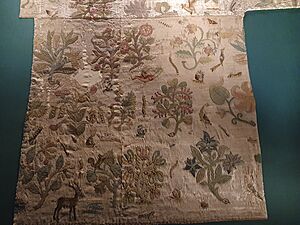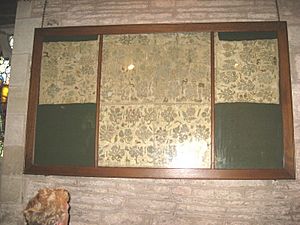Bacton Altar Cloth facts for kids
The Bacton Altar Cloth is a special piece of clothing from the 1500s. Many people believe it is the only dress that still exists from Elizabeth I, a famous Queen of England. This cloth is made of fancy silk and a shiny material called cloth of silver. It has beautiful flowers and animals embroidered (stitched) onto it.
This amazing piece of history was found in 2015 at St Faith's Church in Bacton, England. For hundreds of years, it had been used as an altar cloth in the church. After a lot of careful work to fix and preserve it, the cloth was shown to the public in 2019 and 2020. It was even displayed next to the Rainbow Portrait, a painting where Queen Elizabeth I wears a very similar dress.
Contents
What Does the Bacton Altar Cloth Look Like?
The Bacton Altar Cloth is made from cream-colored silk and a fancy fabric called Italian cloth of silver. Back in Queen Elizabeth's time, there were special rules called Sumptuary Laws. These laws said that only royal family members could wear cloth of silver. This was a big clue that the cloth belonged to someone very important, like the Queen!
The cloth is covered in detailed embroidery. It has colorful flowers, plants, caterpillars, and even deer stitched onto it using silk, silver, and gold threads. The way the embroidery was done shows that a very skilled person made it, meaning it was for a very important owner. Some of the dyes used for the threads came from far away. For example, the red dye came from Mexico, and the blue dye came from India. This shows how much trade happened even back then!
Who Owned the Queen's Dress?
This dress was likely made when Queen Elizabeth I was older, almost 70 years old. It looks very much like the dress she wears in her famous Rainbow Portrait. The style of the embroidered flowers tells us it was made in the 1590s. Also, records from the later part of Elizabeth's rule show she owned such expensive dresses.
It's thought that the dress might have been given to Bacton Church by Blanche Parry. She was a very close friend and helper to Queen Elizabeth. Blanche Parry was from Bacton and worked for the Queen for 56 years, longer than anyone else. She was in charge of the Queen's jewels and personal belongings. Blanche Parry never married and was very loyal to Elizabeth. When she died in 1590, she left money to the church and a home for poor people in Bacton.
The people at St Faith's Church kept the Altar Cloth safe for centuries because they saw it as a special, holy item. They always remembered its possible connection to Blanche Parry and Queen Elizabeth's court. In the 1870s, some even thought Blanche Parry had embroidered the cloth herself!
How Was the Cloth Rediscovered?
The Bacton cloth was shown in London in 1885. In 1909, it was put into an oak frame and hung on a wall in Bacton Church. It was placed away from direct sunlight, which helped keep it from fading for over 100 years.
In the early 1900s, a man named Sir Lionel Cust, who was in charge of the King's pictures, realized how important the cloth was. His wife, Sybil Cust, had studied and written about Blanche Parry. Lionel Cust then wrote an article in 1918 about how similar the cloth was to the clothes Queen Elizabeth I wore in her portraits.
The Cloth Becomes Famous Again
In 2015, a researcher named Ruth Elizabeth Richardson was writing a new book about Blanche Parry. She looked at the Bacton cloth and understood how rare and important it was. Later, Eleri Lynn, a curator (someone who looks after museum collections) at the Historic Royal Palaces, saw Richardson's photos of the cloth online.
Lynn went to see the cloth herself. She found that it was incredibly well-made. She also saw signs that it had been cut and shaped like a dress. Lynn realized that this was a truly unique discovery, as it was the only known piece of clothing with direct embroidery from that time period still existing anywhere in the world. This led to the cloth being carefully fixed and then shown to the public at Hampton Court Palace.
The Bacton Altar Cloth will be on display at the Guildhall Art Gallery from September to November 2023.
See also
- List of individual dresses




